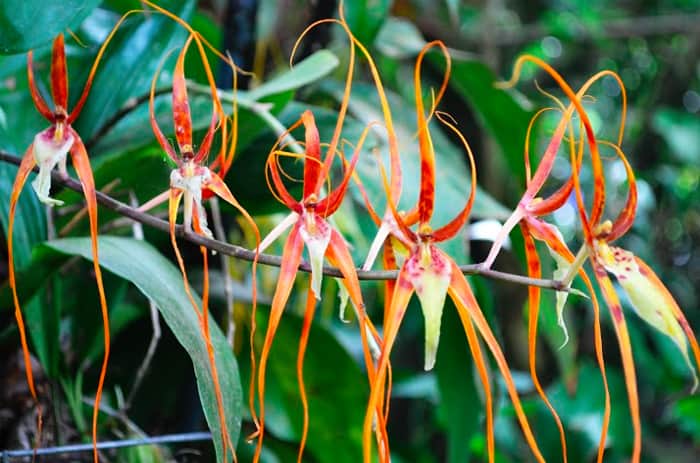SANTA ELENA, Puntarenas — You’ve hiked to the continental divide in the Monteverde Cloud Forest Reserve, screamed your lungs out ziplining through the cloud forest canopy, and scouted for eye shine during a night hike in Santa Elena. If you’re ready for something a little more relaxing, I suggest you make room for the Orchid Garden. It’s a hidden Monteverde gem and here’s why:
The Orchid Garden has been open for 10 years, and with government permission to collect orchids, 600 species now take turns blooming along the garden’s approximately 200-meter leaf-littered path. Otherwise, harvesting orchids is illegal, which is what makes the garden unique.
A forest of flowers? Tucked away behind two coffee hot spots, Blue Morpho and Orchid Café?
Say no more.
I suppressed a giggle when the bearded gentleman at the front desk greeted me and handed me a magnifying glass. Why do I need this to look at flowers? He either caught my smirk or read my mind and said, “Trust me, you’ll need that.”
He pointed at the bark of the tree nearest me, enveloped by a root thin as floss, and motioned for me to look through the magnifying glass.
Minuscule but vibrant orchids peeked out from under the leaves. I had entered another world, one in which perhaps Hans Christian Andersen’s tiny Thumbelina lives. My eyes traced the trunks of surrounding trees. I was surrounded by a kaleidoscope of orchid roots. Yet I was looking at just a fraction of the 1,600 species of orchids in Costa Rica.
Intoxicated with orchid scents, I plopped down on a couch outside the garden’s greenhouse and mentally sorted some newly acquired orchid trivia.
Here are five facts about orchids you might not have known:
1. Vanilla flavoring comes from orchids. Yep, that distinct creamy taste in ice cream, lattes, and desserts is made from a tiny bean produced by a particular variety of orchid. (Thank you, Mayans and Aztecs, for this flavorful discovery). Europeans decided to give production a go in the 1500s, but struggled to do so for hundreds of years. At the time they didn’t know that orchids cannot self-pollinate, and the tiny bees responsible for pollination were overseas in their native tropical environments.
2. Although not visible to the human eye, the main orchid petal resembles a female insect. It’s one of Mother Nature’s cruel tricks, fooling the male insect into thinking the petal is a female of its kind, thereby helping to pollinate the orchid. If a particular orchid’s pollinating insect numbers are dwindling or disappear, that species of orchid will be threatened with extinction, as there are no other insects in the wild capable of pollinating the flower.
3. Orchids are bilaterally symmetric, meaning they can be divided into two equal parts, similar to a human face or body. They grow in terrestrial and subterranean environments but most commonly (80-90 percent of them) as epiphytes, meaning on other trees and plants. Have a clingy younger sibling? Yeah, it’s like that.
4. Orchids return favors. To put it scientifically, orchid seeds are so tiny that they contain no resources. The only way they can germinate is if they happen to land among a specific fungus, from which they begin to draw nutrients and grow. But after reaching adulthood, the orchid begins returning sugars to the fungus.
5. Orchids are the largest identified plant species in the world, with 30,000 varieties.
Oh, and while visiting the Orchid Garden, beware of the guard dog….







